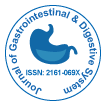Stag Beetle Knife: A Promising Endoscopic Approach for Zenker's Diverticulum Treatment
Received Date: Apr 18, 2024 / Published Date: Feb 13, 2025
Abstract
Background and aim: The SB knife, a unique scissor-shaped device with rotating insulated monopolar blades, is increasingly employed in the endoscopic management of ZD and this systematic review and meta-analysis aims to evaluate its overall safety, efficacy and feasibility.
Methods: A thorough search of electronic databases and conference abstracts was conducted until November 2023. Meta-analysis utilized the random-effects model, with I2% assessing heterogeneity. Subgroup analysis was based on sample size, employing SMD and a 95% Confidence Interval (CI) for continuous variables. Key outcomes included clinical success, recurrence rate, adverse events and improvement in dysphagia score.
Results: Incorporating eight studies with 299 patients (60.5% males), mean age 72.75 ± 2.86 years and ZD size 2.66 ± 0.52 cm, procedures lasted 23.06 ± 10.00 minutes. Clinical success was achieved in 86% (95% CI: (81-90; I2 0%)) after 10.98 sessions and 22.74% required multiple (up to 4) sessions. The recurrence rate was 15% (11-20; I2 0%). Intraprocedural complications occurred in 9% (5-13; I2=29%), primarily minor bleeding (9.6%), microperforation (2%), odynophagia (1.3%) and fever (1.05%). Late-onset bleeding occurred in 3.2% after 1 week. Adverse events were conservatively managed, and subgroup analysis by sample size indicated a significant difference in mean sessions (p=0.02). Dysphagia score improvement was SMD (95% CI) 1.59 (2.27-0.91; I2 97%), p<0.01, with a mean 22.23 ± 11.47 months follow-up.
Conclusion: The meta-analysis confirms SB knife's success in ZD, displaying excellent safety and dysphagia improvement; however, further research is needed to define optimal patient cohorts and compare them with other management techniques.
Citation: Bhatia MK, Ogwor O, Doukas PG, Bhatia MK, Doukas S, et al. (2025) Stag Beetle Knife: A Promising Endoscopic Approach for Zenker's Diverticulum Treatment. J Gastrointest Dig Syst 15: 850.
Copyright: © 2025 Bhatia MK, et al. This is an open-access article distributed under the terms of the Creative Commons Attribution License, which permits unrestricted use, distribution and reproduction in any medium, provided the original author and source are credited.
Select your language of interest to view the total content in your interested language
Share This Article
Recommended Journals
Open Access Journals
Article Usage
- Total views: 302
- [From(publication date): 0-0 - Dec 23, 2025]
- Breakdown by view type
- HTML page views: 214
- PDF downloads: 88
